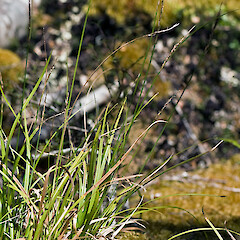Carex penalpina
Common name
bastard grass, hook sedge
Synonyms
Uncinia fuscovaginata Kük.; Uncinia purpurata Petrie var. fuscovaginata Cheeseman, Uncinia fuscovaginata var. fuscovaginata, Uncinia fuscovaginata var. caespitans Hamlin
Family
Cyperaceae
Flora category
Vascular – Native
Endemic taxon
Yes
Endemic genus
No
Endemic family
No
Structural class
Sedges
NVS code
The National Vegetation Survey (NVS) Databank is a physical archive and electronic databank containing records of over 94,000 vegetation survey plots - including data from over 19,000 permanent plots. NVS maintains a standard set of species code abbreviations that correspond to standard scientific plant names from the Ngä Tipu o Aotearoa - New Zealand Plants database.
UNCFUS
Chromosome number
2n = 88
Current conservation status
The conservation status of all known New Zealand vascular plant taxa at the rank of species and below were reassessed in 2017 using the New Zealand Threat Classification System (NZTCS) – more information about this can be found on the NZTCS website. This report includes a statistical summary and brief notes on changes since 2012 and replaces all previous NZTCS lists for vascular plants.
Please note, threat classifications are often suggested by authors when publications fall between NZTCS assessment periods – an interim threat classification status has not been assessed by the NZTCS panel.
- Conservation status of New Zealand indigenous vascular plants, 2017 . 2018. Peter J. de Lange, Jeremy R. Rolfe, John W. Barkla, Shannel P. Courtney, Paul D. Champion, Leon R. Perrie, Sarah M. Beadel, Kerry A. Ford, Ilse Breitwieser, Ines Schönberger, Rowan Hindmarsh-Walls, Peter B. Heenan and Kate Ladley. Department of Conservation. Source: NZTCS and licensed by DOC for reuse under the Creative Commons Attribution 4.0 International licence.
2017 | Not Threatened
Previous conservation statuses
2012 | Not Threatened
2009 | Not Threatened
2004 | Not Threatened
Distribution
Endemic. New Zealand: North Island (Volcanic Plateau, Kaimanawa, Ruahine and Tararua Ranges), South Island (widespread except in Westland) and Stewart Islands.
Habitat
Upper montane to alpine. In sparse forest and subalpine scrub, snow-tussock and short-tussock grassland, herbfield, and on ultramafic rock, scree and fellfield.
Detailed description
Shortly rhizomatous or loosely tufted, bright green, yellow-green or glaucous plants. Rhizome woody, 2–3 mm diameter Culms 80–400 × 0.7–2.0 mm, stiffly erect, scabrid below inflorescence; basal bracts dull reddish brown or dull dark brown. Leaves 4–7 per culm, < or ± = culms, 1.5–5.0 mm wide, rigid, curved to falcate, coriaceous, margins usually harshly scabrid but occasionally almost glabrous, upper surface near tip scabrid. Spikes 20–75 × 3–7 mm, linear to subclavate, occasionally bracteate, female flowers usually 10–15, mostly close-set, rarely rather lax, internodes to 6 mm long at base of spike, 2–3 mm long above. Glumes slightly >, = or slightly < utricles, persistent, ovate, obtuse or lowermost subacute, coriaceous, greenish brown, light brown or dull dark brown, rarely bright chestnut-brown, midrib broad, green, margins white, hyaline. Utricles 5.0–7.5 × 1.5–2.0 mm, plano-convex or concavo-convex, ovate or obovate, many-nerved, tapered above to a beak 1.5–2.0 mm long, slightly narrowed at the base to a stipe 1–2 mm long.
Similar taxa
Carex penalpina appears closely allied to the much less common, biological sparse C. purpurata (Petrie) K.A.Ford. Both species have leaf-sheaths, leaves and glumes without any red pigmentation, close-set flowers, utricles 1–2 mm diameter and wiry culms up to 500 mm long. From Carex purpurata, C. penalpina differs by the culms with are 0.7–2.0 mm rather than c. 0.5 mm diameter, and by the glumes which are more or less equal rather than ½–¾ the length of the utricles. Carex purpurata is confined to Otago where it is usually found under dry rock overhangs or in grey scrub, while C. penalpina is found in both North and South Islands and is ecologically more wide ranging (see Habitat).
Flowering
October–November
Fruiting
November–May
Propagation technique
Easily grown from fresh seed and by division of established plants, though these may take a while to settle. Prefers moist soil. Once established will tolerate a wide range of conditions. This species would repay critical horticultural investigation. The glaucous form found in northern South Island ultramafics is especially attractive.
Etymology
carex: Latin name for a species of sedge, now applied to the whole group.
Where To Buy
Not Commercially Available
Notes on taxonomy
Carex penalpina is a very variable species. A glaucous form apparently confined to the ultramafic rocks of the northern South Island is especially distinctive and may warrant further investigation.
Attribution
Description adapted from Moore and Edgar (1970). Fact sheet prepared by Peter J. de Lange 17 August 2006.
References and further reading
Moore LB, Edgar E. 1970. Flora of New Zealand, Volume II. Indigenous Tracheophyta: Monocotyledones except Gramineae. Government Printer, Wellington, NZ. 354 p.
NZPCN Fact Sheet citation
Please cite as: de Lange, P.J. (Year at time of access): Carex penalpina Fact Sheet (content continuously updated). New Zealand Plant Conservation Network. https://www.nzpcn.org.nz/flora/species/carex-penalpina/ (Date website was queried)







